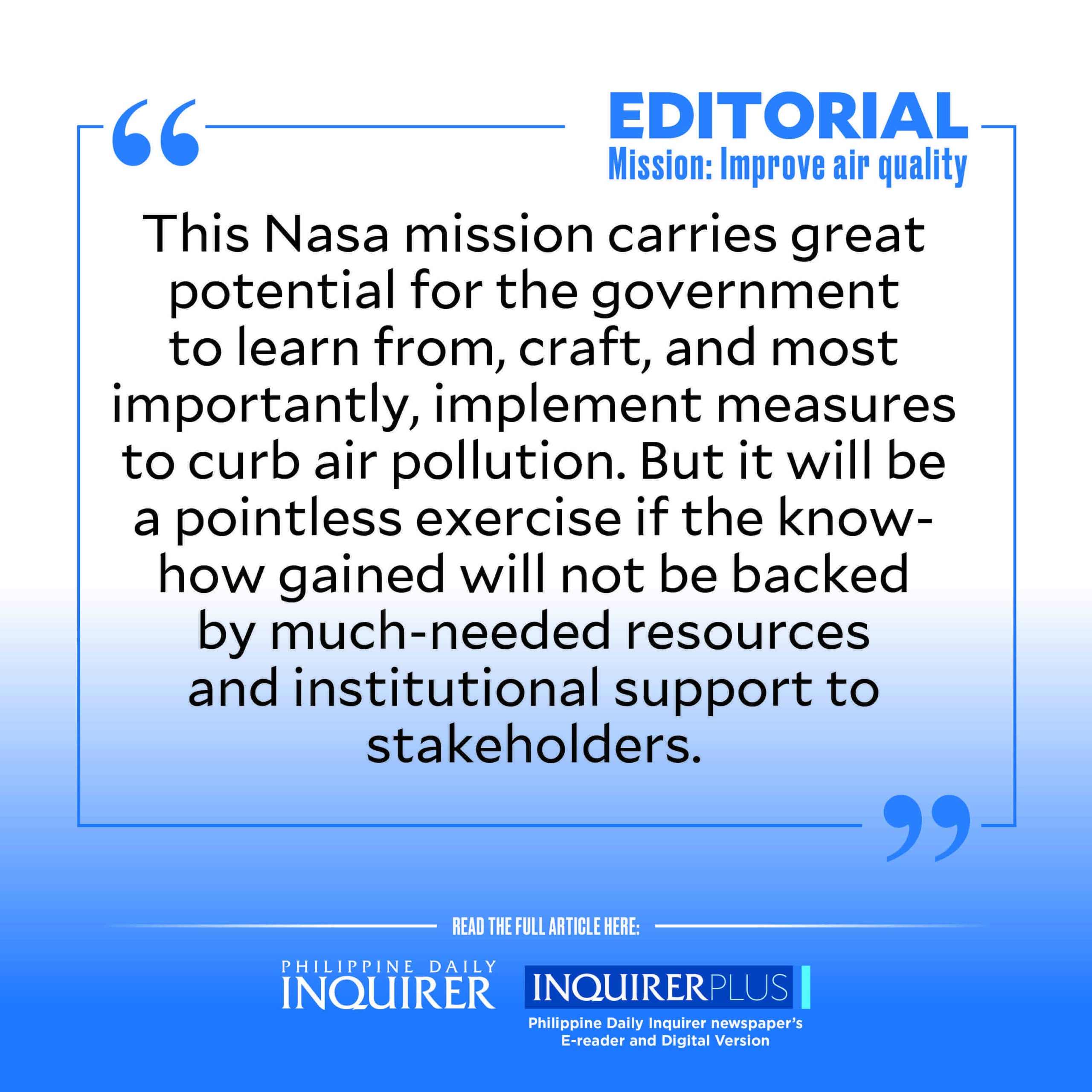Mission: Improve air quality

Air pollution, despite the existence of numerous policies and laws, has long been the Philippines’ problem causing thousands of deaths annually and risking the health of millions more Filipinos.
But there’s a whiff of positive anticipation in the air with the recent announcement that the Department of Environment and Natural Resources (DENR) has joined an international collaboration with the National Aeronautics and Space Administration (Nasa) to study and address air quality issues.
Article continues after this advertisementThe country’s participation in the Nasa science mission, dubbed the “Airborne and Satellite Investigation of Asian Air Quality” covering four Asian countries, is expected to lead to significant advances in understanding air pollution and improving the government’s ability to tackle the problem with the use of air quality models, accurate forecasts, and effective policies.
To be fair, our air quality has improved over the years but major sources of air pollution remain: according to studies, 80 percent come from motor vehicle emission and 20 percent from the burning of fossil fuels like coal and oil.
‘Acutely unhealthy’
There is also the seasonal “acutely unhealthy” level of pollutants brought by the burning of fireworks and firecrackers to traditionally welcome the new year that even reached “emergency” status in some areas at the beginning of this year.
Article continues after this advertisementAt the height of the COVID-19 pandemic, the environment was given a respite when lockdowns were imposed and land, sea, and air transport were banned. For once, the air cleared especially in Metro Manila. But as soon as restrictions were eased, cars returned to the roads and factories resumed businesses, bringing toxic air back to the environment.
The pandemic was a lost opportunity for the government to beef up its emissions reduction strategies and revisit laws including the Clean Air Act whose national emission standards for source-specific air pollutants have not been updated since 1999.
Independent research organization Centre for Research on Energy and Clean Air (Crea) said air pollution was the Philippines’ third highest risk factor driving death and disability due to noncommunicable diseases such as chronic heart and lung diseases, lung cancer, stroke, and respiratory infections; it caused 66,230 deaths in 2019.
Biggest flying lab
Crea noted that air pollution is detrimental to health and impacts health-care and labor systems, and costs the country P4.5 trillion: 98 percent or P4.43 trillion is lost to premature deaths; P53 billion is lost to disabilities that lower quality of life and economic productivity; and P24.7 billion is lost to work absences due to illness. If air quality is improved, Crea said, the cost of air pollution on the economy would decrease by 30 percent.
This collaboration with Nasa, Environment Secretary Maria Antonia Yulo Loyzaga said, is expected to help the government advance its air quality monitoring techniques including satellite data, ground-based observations, and atmospheric modeling tools, as well as craft evidence-based policymaking and targeted interventions.
The country has sent five engineers and air quality specialists from the DENR-Environmental Management Bureau to join in the project. They participated in research flights between Feb. 6 and 13 onboard Nasa’s DC-8 aircraft, the biggest flying lab, that can observe the atmosphere and detect various pollutants such as particulate matter, ozone, carbon dioxide, and methane, which are not usually locally measured above the ground.
Dangers in the air
The data it collects can lead to the development of more accurate models to forecast air quality that currently relies on ground stations and satellites.
This Nasa mission carries great potential for the government to learn from, craft, and most importantly, implement measures to curb air pollution. But it will be a pointless exercise if the know-how gained will not be backed by much-needed resources and institutional support to stakeholders. They include putting more resources into improving air quality monitoring as well as reducing reliance on fossil fuels. Then there is also the need to assist those affected by the public utility vehicle modernization program, particularly jeepney drivers, in upgrading their vehicles to be Euro-4 compliant to reduce the number of polluters on the roads. The government also needs to outlaw vehicles that are 15 years or older because they are another source of toxic emissions and at the same time improve public transport to lessen dependency on private car use. It should also review the Clean Air Act to ensure that its standards remain relevant to current environmental realities.
These conditions, once accomplished, will greatly complement the country’s participation in the Nasa mission. All the high expectations this mission has generated depend on how the government will put to good use the new knowledge and technology acquired to address the dangers in the air.
















